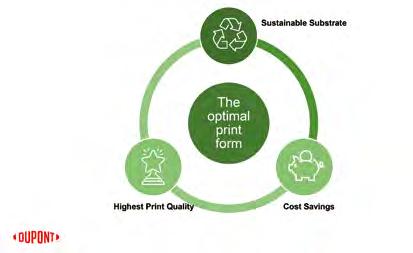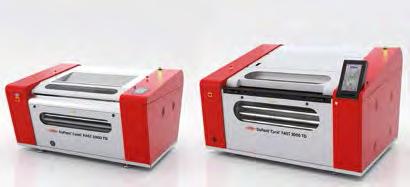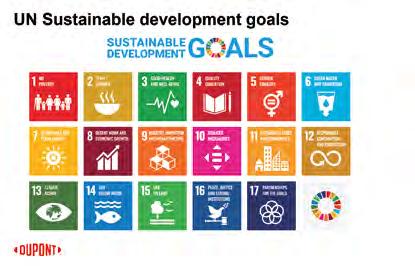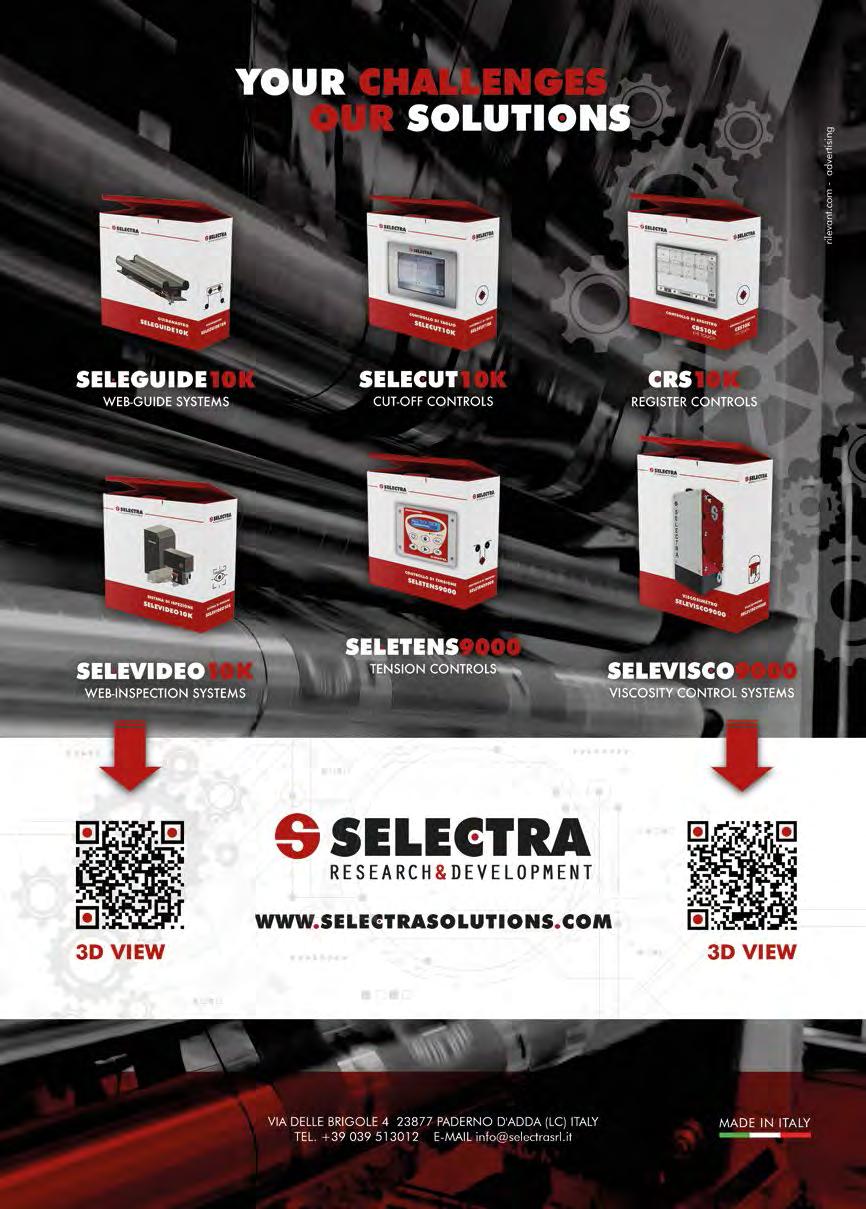
16 minute read
DuPont’s view on the latest trends for an increasingly sustainable packaging industry
“Quando abbiamo iniziato a parlare di sostenibilità nel 2008 la parola sostenibile era poco più che uno slogan. Oggi per noi essere sostenibili significa sviluppare dei prodotti specifici affinché si possa ottenere un packaging che sia maggiormente sostenibile, con un costo finale allineato al tradizionale e stampato con gli stessi standard di qualità”, dice Mario Castelli
When we started talking about sustainability in 2008, the word sustainable was little more than a slogan. Today, for us being sustainable means developing specific products so that we can obtain a packaging that is more sustainable, with a final cost aligned with the traditional one and printed with the same quality standards.
Advertisement
quando in realtà oggi l’aspetto principale è valutarne la funzionalità in relazione al compito chiamato a svolgere e la sua effettiva riciclabilità, senza dimenticare che quasi sempre è maggiore l’impatto ambientale del prodotto contenuto nella confezione, piuttosto che la confezione stessa che deve proteggere, trasportare e quindi garantire che un alimento non venga sprecato. E sappiamo quanto lo spreco alimentare sia un altro aspetto da considerare nel percorso della sostenibilità. Webinar, eventi e incontri di associazioni hanno la sostenibilità come tema principe. Un dato che sicuramente emerge da tutto questo discutere e da questi confronti è l’importanza della necessità di misurare la sostenibilità e lo strumento migliore per farlo e per contrastare il greenwashing è l’LCA, processo oggettivo di valutazione dei carichi ambientali connessi con un prodotto, un servizio o un’attività, includendo l’intero ciclo di vita del prodotto, per capire quali siano i principali contributi all’impatto ambientale di un prodotto o di un servizio e quindi agire per abbatterli. Questa analisi è importante soprattutto perché è evidente che non ci sono ricette o percorsi universali per diventare sostenibili; ognuno, dal singolo individuo all’azienda, deve costruirseli da solo. Altrettanto chiaro che nessuna persona o azienda potrà essere sostenibile al 100%, ma l’importante è avvicinarsi all’obiettivo il più possibile.
CARTONE O PLASTICA?
E l’impatto degli imballaggi? Quelli in cartone sono definiti ecologici per loro natura, sono riciclabili e biodegradabili al 100%, e il cartone riciclato non dura di meno o è meno resistente. Invece la caratteristica principale degli imballaggi
ENGLISH Version DuPont’s view on the latest trends for an increasingly sustainable packaging industry
DUPONT AS A LEADING COMPANY IS CALLED UPON TO PROVIDE THE MARKET CONCRETE ANSWERS ON SUSTAINABILITY. THIS SERIOUS COMMITMENT THAT CAN NO LONGER BE POSTPONED WAS THE FOCUS OF DISCUSSION AT LAST SEPTEMBER COMPANY MEETING WHERE THE LATEST TRENDS AND TECHNOLOGICAL SOLUTIONS TO TRANSLATE THEORETICAL DICTATES INTO CONCRETE ACTIONS WERE ANALYZED WITH INDUSTRY EXPERTS.
Sustainability is now a must for any type of manufacturing business, and flexo packaging printing is not exempt. But, if until a few years ago it was talked about as an almost abstract subject, with very futuristic time horizons, this is no longer the case, and leading companies such as DuPont are questioning themselves internally in order to be able to provide concrete answers and solutions to their target markets. It is the customer who is asking for it, and the industry can no longer be caught unprepared. DuPont has always been committed to the sustainable development of the industry, and there are many questions that need to be answered. Climate change is undoubtedly at the top of the list; it is now quite evident how much human activity affects the climate, and what seemed unthinkable just a few years ago are now tangible issues that are there for all to see. The environmental one is certainly an important aspect, where we always start to address sustainability, but it is not the only one. Today it is increasingly clear that sustainability is a path that each reality, with the help of specialized consultants, can build itself to give the market those answers and reassurances required to create trust in a brand. But above all, environmental sustainability, as also emerged during the last Gipea conference, must also go hand in hand with social and especially economic sustainability. Because it is true that everything has a price, and sustainability costs money, but then is the market that always has the last word.
SUSTAINABILITY IN THE PACKAGING INDUSTRY: A COMMON GOAL Sustainable growth, which today all technology but also service providers should aim at, is not just a phased program to improve the environmental performance of their proposals, but a comprehensive way of working to deliver significant economic value and open new opportunities. Operators for their part should abandon the idea that sustainable technologies are just a compromise or marketing operations, because today the sustainable revolution is here and it is disrupting all sectors. It is good for the environment and society, but it puts pressure on everyone, suppliers and users. Everywhere we keep hearing this word, even at the recent K trade show, the world’s most important exhibition for the plastics industry, the leitmotif was this, and indeed we noticed a great excitement translated into concrete solutions, by companies operating in the world of plastics, traditionally under the eye of the storm and consumers who are often led to consider this material as unsustainable when in fact today the main aspect is to evaluate its functionality in relation to the task called upon to perform and its effective recyclability, without forgetting that almost always the environmental impact of the product contained in the package is greater than the package itself, which
flessibili è la loro leggerezza; il peso dell’imballo, e quindi del prodotto finito, in fase di trasporto e stoccaggio è inferiore e sono minori il peso e il volume in fase di smaltimento, quando diventa rifiuto. Molto importante è l’aspetto legato al design di un imballaggio, per cui la fase progettuale va considerata come il punto di partenza affinché un imballaggio possa essere pensato per un riutilizzo e a fine vita, per un riciclo al 100%. Si potrebbe obiettare che anche se il cartone richiede meno energia per essere prodotto usa più acqua e produce una gran quantità di rifiuti solidi; inoltre il cartone è più pesante e voluminoso per cui produce più emissioni di CO2 associate con il trasporto. Ma il cartone deriva da una risorsa rinnovabile e viene prodotto sempre più spesso usando energia rinnovabile e si ricicla più facilmente. Relativamente alla plastica le percentuali di riciclo stanno aumentando, anche se le percentuali di riciclo del cartone sono tre volte tanto e i prodotti in cartone sono fatti con cartone riciclato. Insomma, tanti i pro e i contro, ma in ultima analisi l’obiettivo primario, a prescindere dalla scelta di usare imballaggi in plastica o cartone, è ridurre i rifiuti, riducendo quindi i materiali utilizzati per produrli (lastre, prodotti chimici, inchiostri), riutilizzando gli imballaggi e riciclando il più possibile. E in questo percorso tutti sono chiamati a svolgere un ruolo, condividendo esperienze e informazioni tra tutti gli stakeholder della filiera, dai produttori di materiali e tecnologie, fino agli stampatori-converter e infine la GDO e i consumatori. DuPont ha svolto internamente un’analisi del ciclo di vita incentrata sulle differenze e l’impatto tra la stampa flessografica e rotocalco utilizzando l’esempio degli imballaggi flessibili, quindi, nell’area flessografica, la produzione di lastre confrontando la tecnologia a solventi e termica, con un’analisi approfondita nel mondo della stampa flexo su cartone ondulato e per sacchetti di carta. E per quanto riguarda le lastre? Ovviamente la lastra ottimale è quella in grado di fornire la più alta qualità di stampa, su supporti sostenibili e a costi contenuti.
Ne parliamo in questa intervista con Christian Apenberg, Regional Marketing Manager EMEA & AP – Cyrel® Solutions, DuPont e Mario Castelli, Sales Manager Southern Europe and Northern Africa – Cyrel® Solutions, DuPont.
Pensando al 2030, quali azioni concrete metterete in atto per raggiungere gli obiettivi della sostenibilità?
“DuPont si è impegnata a fissare obiettivi scientifici per ridurre
must protect, transport and thus ensure that a food is not wasted. And we know how food waste is another aspect to consider in the sustainability journey. Webinars, events and association meetings have sustainability as a major theme. One thing that certainly emerges from all this discussion and comparisons is the importance of the need to measure sustainability, and the best tool to do so and to counteract greenwashing is the LCA, an objective process of assessing the environmental impact associated with a product, service or activity, throughout the entire life cycle of a product, to understand what are the main contributions to the environmental impact of a product or of a service and then act to eliminate them. This analysis is especially important because it is clear that there are no universal recipes or pathways to becoming sustainable; everyone, from the individual to the company, must build them for themselves. Equally clear is that no person or company will be 100% sustainable, but the important thing is to get as close to the goal as possible.
CARDBOARD OR PLASTIC? What about the impact of packaging? Those made of cardboard are defined as environmentally friendly by their very nature; they are 100% recyclable and biodegradable, and recycled cardboard does not last less or is less durable. Instead, the main characteristic of flexible packaging is its light weight; the weight of the packaging, and therefore of the finished product, during transport and storage is less, and the weight and volume during disposal, when it becomes waste, are less. Very important is the design aspect of packaging, so the design phase should be considered as the starting point so that a package can be designed for reuse and at the end of its life, for 100% recycling. It could be argued that although cardboard requires less energy to be produced it uses more water and produces a large amount of solid waste, plus cardboard is heavier and bulkier so it produces more CO2 emissions associated with transportation. But cardboard is derived from a renewable resource and is increasingly produced using renewable energy and is more easily recycled. Further to plastic, recycling rates are increasing, although cardboard recycling rates are three times as high and cardboard products are made from recycled cardboard. In short, many pros and cons, but ultimately the primary goal, regardless of whether you choose to use plastic or cardboard packaging, is to reduce waste, thus reducing the materials used to produce it (plates, chemicals, inks), reusing packaging and recycling as much as possible. And in this journey everyone is called upon to play a role, sharing experiences and information among all the stakeholders in the supply chain, from the producers of materials and technologies, down to printer-converters and finally the large-scale retail trade and consumers. DuPont carried out internally a Life Cycle Analysis focused on the differences and impact between flexo and gravure printing using the example of flexible packaging, and then, in the flexo area platemaking comparing solvent technology and thermal development, with an in-depth analysis in the world of flexo printing on corrugated board and for paper bags. What about plates? Obviously, the optimal plate is the one that can provide the highest print quality, on sustainable and cost-effective substrates. We discuss this in this interview with Christian Apenberg, Regional Marketing Manager EMEA & AP – Cyrel® Solutions at DuPont and

le emissioni di gas serra (GHG) in linea con l’iniziativa Science Based Targets (SBTi), una partnership tra CDP (ex-Carbon Disclosure Project), Global Compact delle Nazioni Unite, World Resources Institute (WRI) e WWF. Ciò include riduzioni concrete delle emissioni Scope 1 e 2 (cioè dirette e indirette) entro il 2030, obiettivi che molto probabilmente l’attività di Cyrel® Solutions supererà. DuPont si è inoltre impegnata ad arrivare a emissioni zero entro il 2050. In DuPont™ Cyrel®, lavoriamo continuamente per ridurre l’impatto ambientale dei nostri prodotti e per fornire ai nostri clienti un flusso di lavoro ottimizzato sia per i sistemi a solvente che termici. Ci sono diversi progetti in lavorazione e i risultati saranno continuamente riportati in LCA aggiornate. È particolarmente importante per noi guardare al quadro completo, che include le materie prime che utilizziamo per produrre i nostri prodotti, imballaggi per fornire i sistemi, i flussi di lavoro e i materiali di consumo più efficienti per garantire che anche i nostri clienti possano migliorare la loro impronta ambientale. Esempi recenti sono nell’ultimo aggiornamento del LCA, che afferma un vantaggio complessivo del 38% in meno di CO2 per il flusso di lavoro termico Cyrel® FAST rispetto al solvente, ma anche lo sviluppo di un nuovo solvente, Cyrel® Flexosol-X, che elimina componenti pericolosi oltre a fornire fino al 50% in meno di emissioni di COV”.
Materiali, tecnologie e sostenibilità - le soluzioni DuPont per le esigenze dei mercati dell’imballaggio flessibile, etichette e cartone ondulato
“Ovviamente clienti diversi hanno esigenze diverse e siamo in grado di supportare i clienti nel loro percorso di sostenibilità ed è necessario iniziare ad agire adesso. Crediamo fermamente nella flessografia come tecnologia a più basso impatto per la stampa di imballaggi flessibili, come dimostrato dalla nostra LCA in quanto generalmente consuma meno solventi ed energia e produce meno scarti all’avviamento. La produzione di lastre per queste applicazioni può essere ottimizzata passando alla tecnologia termica: Cyrel® FAST consuma meno elettricità rispetto a un flusso di lavoro con solventi (fino all’81% in meno,
Mario Castelli, Sales Manager Southern Europe and Northern Africa – Cyrel® Solutions at DuPont.
Thinking ahead to 2030, which concrete actions will DuPont put in place to achieve sustainability goals? DuPont has committed to setting science-based targets to reduce greenhouse gas (GHG) emissions in line with the Science Based Targets initiative (SBTi), a partnership between CDP (former Carbon Disclosure Project), the UN Global Compact, World Resources Institute (WRI) and the WWF. This includes concrete reductions of Scope 1 and 2 emissions by 2030 – goals, which the Cyrel® Solutions business will most likely over-achieve. DuPont also committed to deliver zero carbon emissions by 2050. At DuPont™ Cyrel®, we are continuously working on reducing the environmental impact of our products as well as providing our customers with an optimized workflow for both solvent and thermal solutions. There are several projects being worked on and the results will continuously be reported in updated LCAs. It is especially important for us to look at the full picture, which includes the raw materials we use to produce our products, packaging to provide the most efficient systems, workflows and consumables to ensure also our customers can improve their environmental footprint. Recent examples are in the updated LCA, which states an overall benefit of 38% lower CO2 for the thermal Cyrel® FAST workflow process compared to solvent – but also developing a new solvent, Cyrel® Flexosol-X, that eliminates hazardous components as well as providing up to 50% lower VOC emissions.
Materials, technologies, and sustainability - DuPont solutions for the needs of the markets: flexible packaging, labels, corrugated board We understand that different customers have different needs, we are able to support customers on their sustainability journey and we have to start taking actions today. We truly believe in Flexography as the lowest impact technology for flexible packaging printing, as proven by our LCA. It generally consumes less solvent and energy and produces less startup waste. Platemaking for these applications can be optimized by going thermal: Cyrel® FAST consumes less electricity compared to a solvent workflow (up to 81% less, according


secondo un recente studio basato su dati interni ed esterni) ed evita completamente l’uso e la manipolazione di solventi organici. Per il cartone ondulato, dove predominano le lastre con rilievo profondo, supportiamo i nostri clienti in diversi modi: da una parte forniamo lastre più sottili, supportate da materiale in schiuma per il montaggio, che contribuiscono a ridurre l’impatto ambientale. L’altro punto, forse ancora più importante, è supportare la tendenza del settore a utilizzare cartoni con un contenuto riciclato più elevato e su cui spesso è più difficile stampare. DuPont™ Cyrel® ha sviluppato lastre fotopolimeriche come Cyrel® DLC per il post-print su cartone ondulato e Cyrel® ESM per il pre-print su carta/cartoncino che offrono una qualità di stampa superiore anche su supporti difficili. In questo modo consentiamo ai converter e ai brand-owner di scegliere materiali con un minore impatto ambientale, senza compromettere la qualità di stampa”.
Il futuro sarà sempre più a favore delle tecnologie termiche o ci sarà ancora spazio per quelle a solvente?
“DuPont è stato un pioniere della produzione di soluzioni termiche per la preparazione di lastre flessografiche e l’industria conferma la sua idoneità per molte applicazioni, non solo per ragioni di sostenibilità. Dall’introduzione di Cyrel® FAST oltre 20 anni fa, sono state installate più di 1.500 unità e continuiamo a innovare con i nostri sistemi di ultima generazione Cyrel® FAST 2000 TD e 3000 TD. Ci aspettiamo un’ulteriore crescita del processo termico. Tuttavia, non abbandoniamo i sistemi a solvente. I nostri recenti lanci di prodotti (solvente Cyrel® Flexosol-X non pericoloso e a basse emissioni, lastre Cyrel® EASY R in versione termica e solvente e Cyrel® Lightning LSH ottimizzato per l’esposizione a LED) confermano il nostro impegno a supportare entrambi i flussi di lavoro”.
Secondo la vostra esperienza, quanto sono importanti le credenziali di sostenibilità verso il cliente finale di un player come DuPont per la decisione di acquisto per prodotti e tecnologie?
“Abbiamo riscontrato un grande interesse per dichiarazioni di sostenibilità supportate dai dati. Molti dei nostri clienti diretti e indiretti stanno lavorando per raggiungere obiettivi di sostenibilità e noi, come fornitori di materiali e sistemi, possiamo supportare la valutazione dello status quo fornendo informazioni basate sui fatti. Nell’attuale contesto economico, la sostenibilità può essere di nuovo messa in secondo piano rispetto agli obiettivi a breve termine, ma il raggiungimento dei requisiti di sostenibilità sarà sempre più un requisito competitivo e finanziario”.

to a recent study based on internal and external data) and avoids the use and handling of organic solvent completely. For corrugated applications, where plates with deep relief requirements are dominant, we support our customers in different ways: by providing thinner plates, supported by mounting foam, contribute to reduce environmental impact. In addition, maybe even more important is supporting the industry trend of using cardboard with higher recycling content that is often more difficult to print on. DuPont™ Cyrel® has developed photopolymer plates like Cyrel® DLC for corrugated postprint and Cyrel® ESM for paper/corrugated preprint that deliver higher print quality even on demanding substrates. With that, we allow converters and brand owners to go for materials with lower environmental impact – without taking a hit on print quality.
Will the future increasingly favor thermal technologies, or will there still be room for solvent-based ones? DuPont has been a pioneer on the thermal flexo platemaking and the industry confirms its suitability for many applications – not only for sustainability reasons. Since the introduction of Cyrel® FAST over 20 years ago, far more than 1,500 units have been installed and we continue to innovate with our latest generation systems Cyrel® FAST 2000 TD and 3000 TD. We do expect a further growth of the thermal process. Nevertheless, we do not abandon solvent systems. Our recent product launches (non-hazardous and low-emission Cyrel® Flexosol-X solvent, Cyrel® EASY R plate series in thermal and solvent and the LED-exposure optimized Cyrel® Lightning LSH) confirm our commitment to support both workflows.
In your experience, how important are the sustainability credentials toward the end customer of a player like DuPont to the purchasing decision for products and technologies? We have experienced high interest in data-supported sustainability declarations. Many of our direct and indirect customers are working to achieve sustainability goals and we, as a material and system supplier, can support assessing the status-quo by providing fact-based information. In the current economic environment, sustainability may be deprioritized again for shorter term goals, but achieving sustainability requirements will increasingly also be a competitive and financial requirement.










